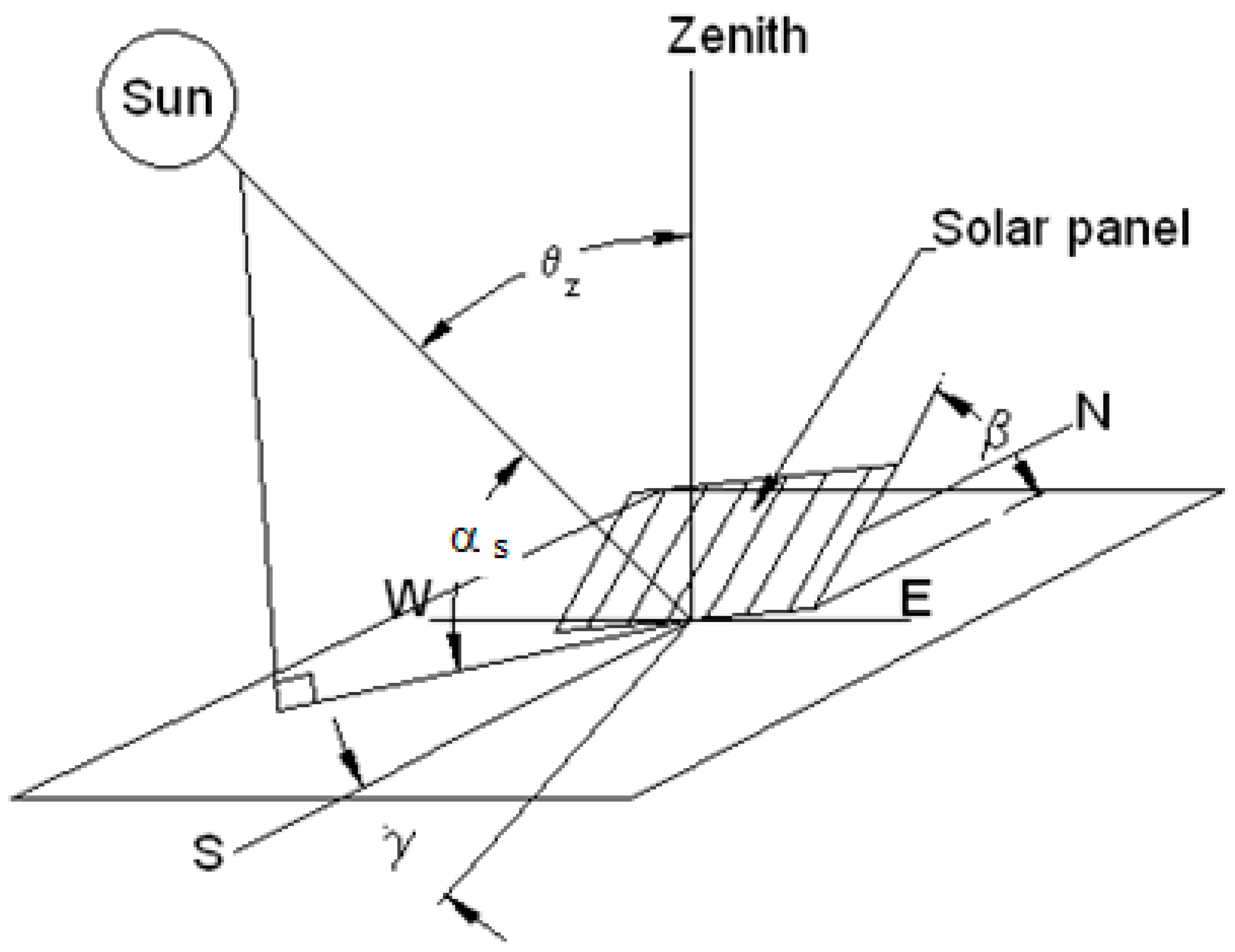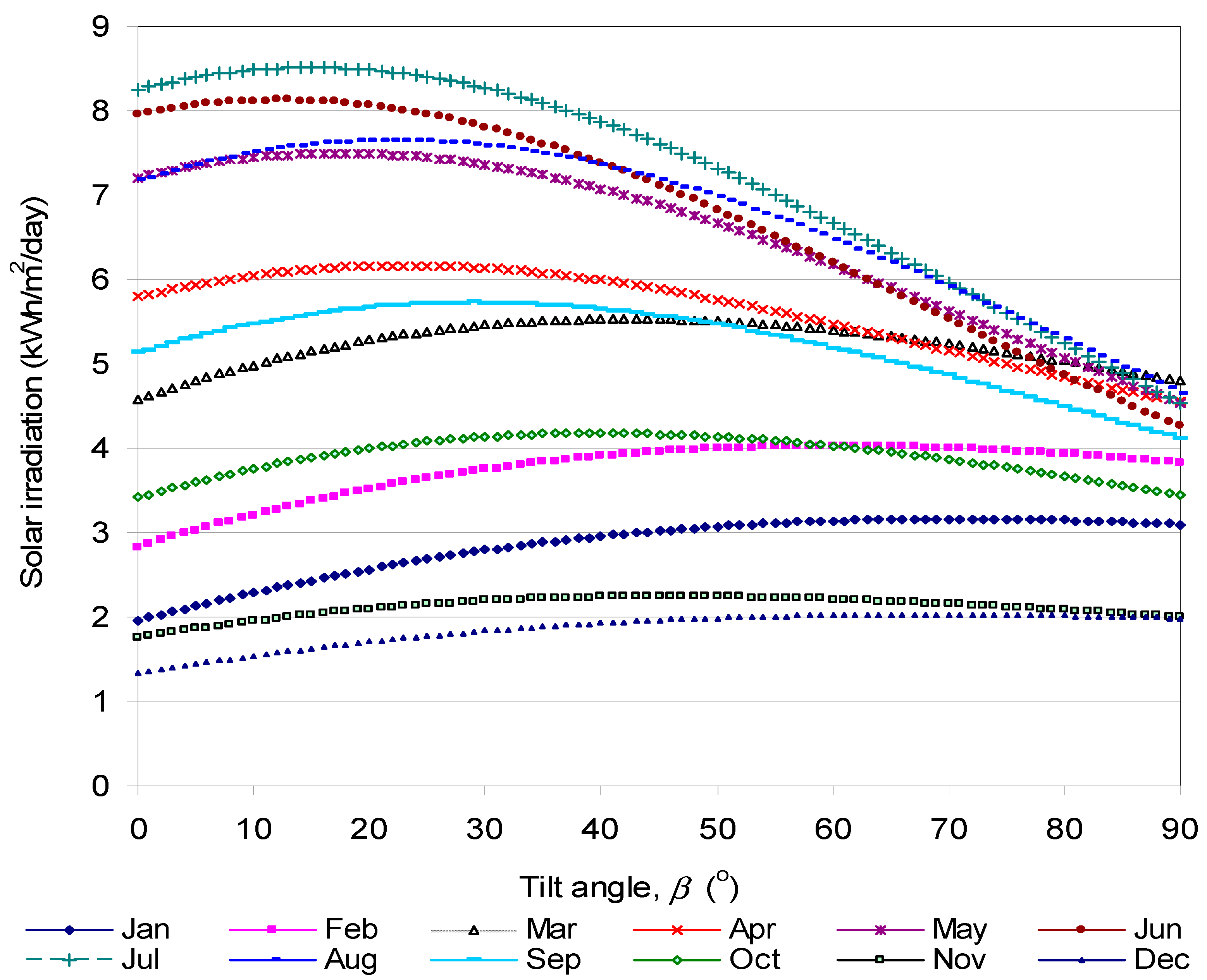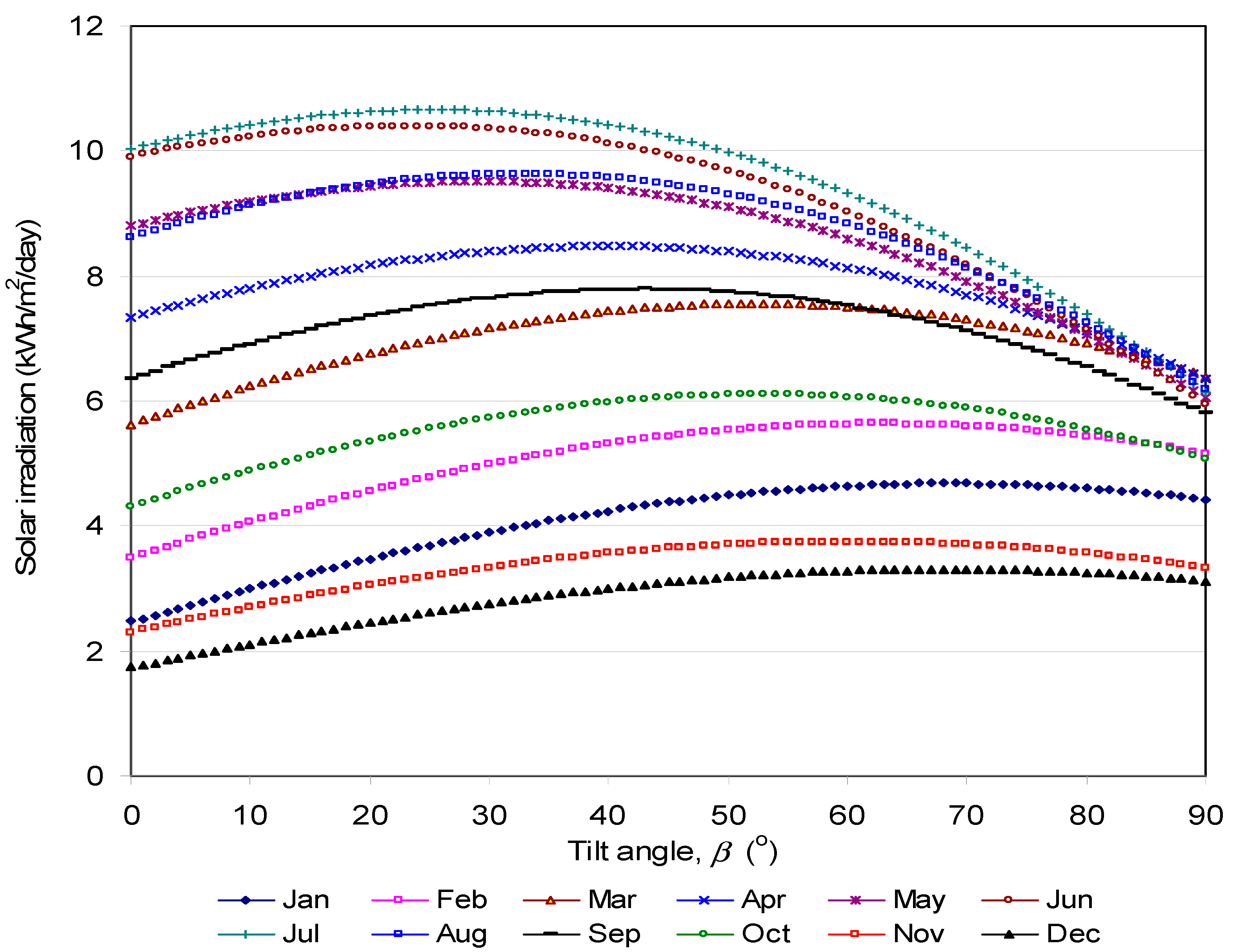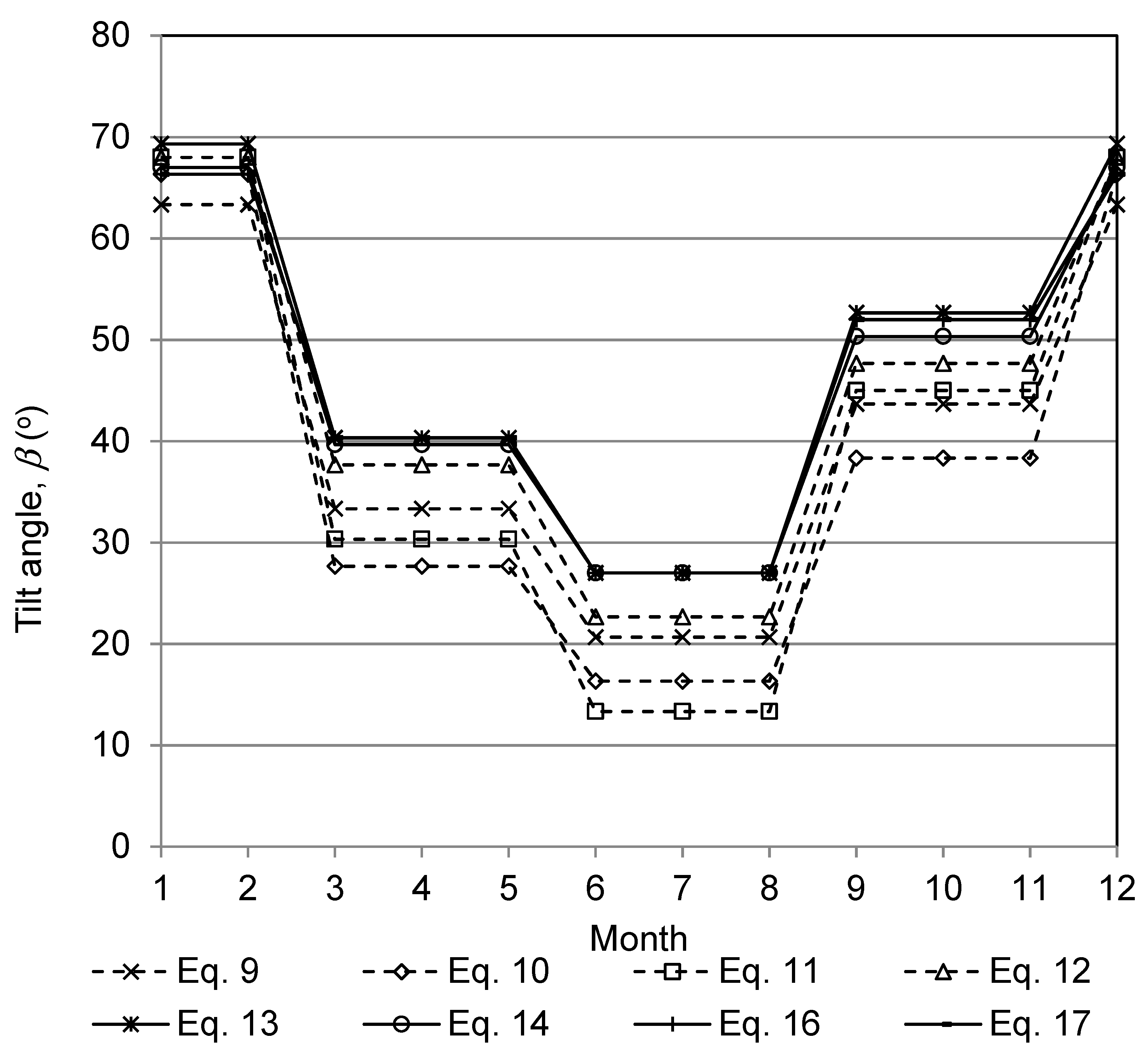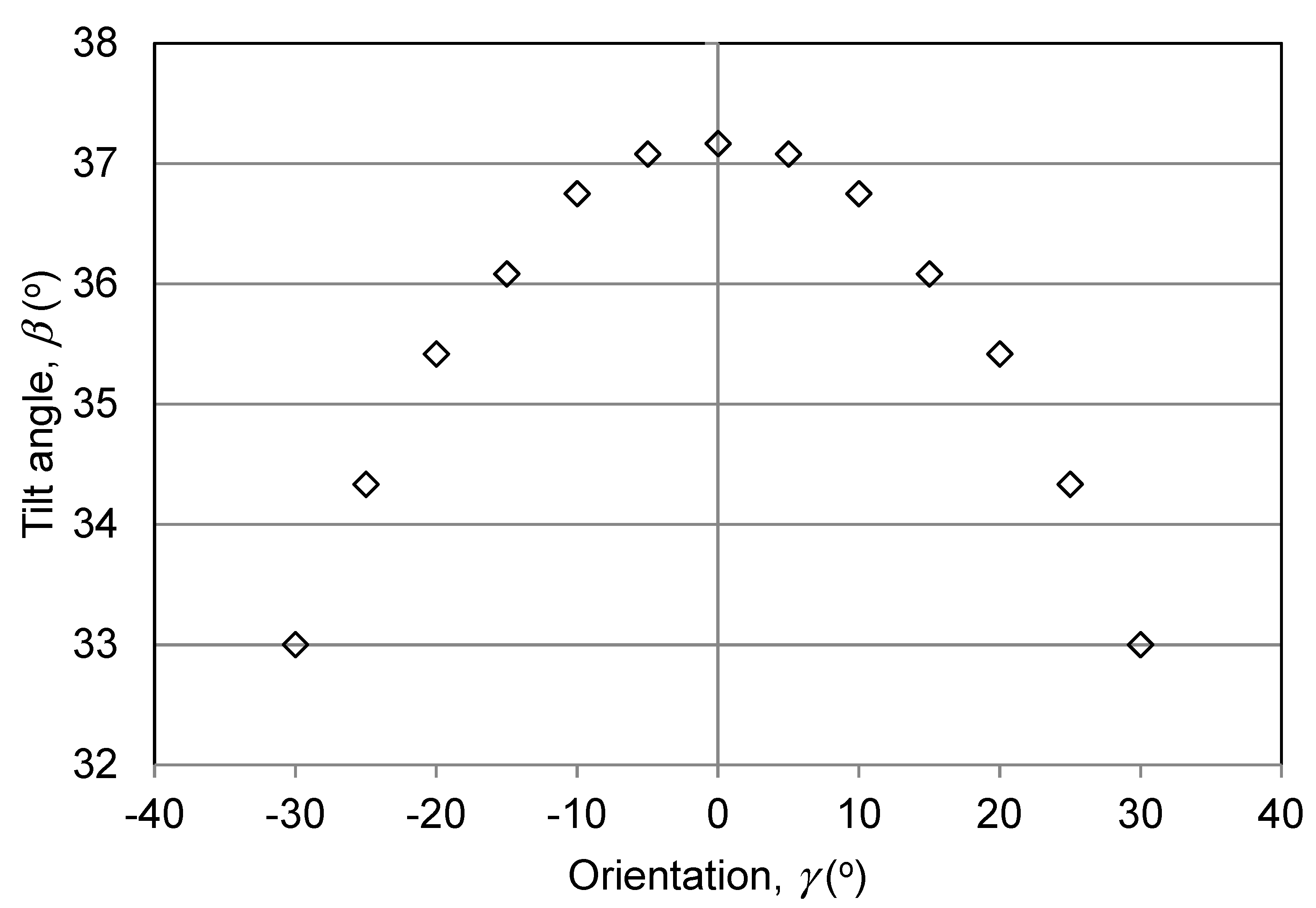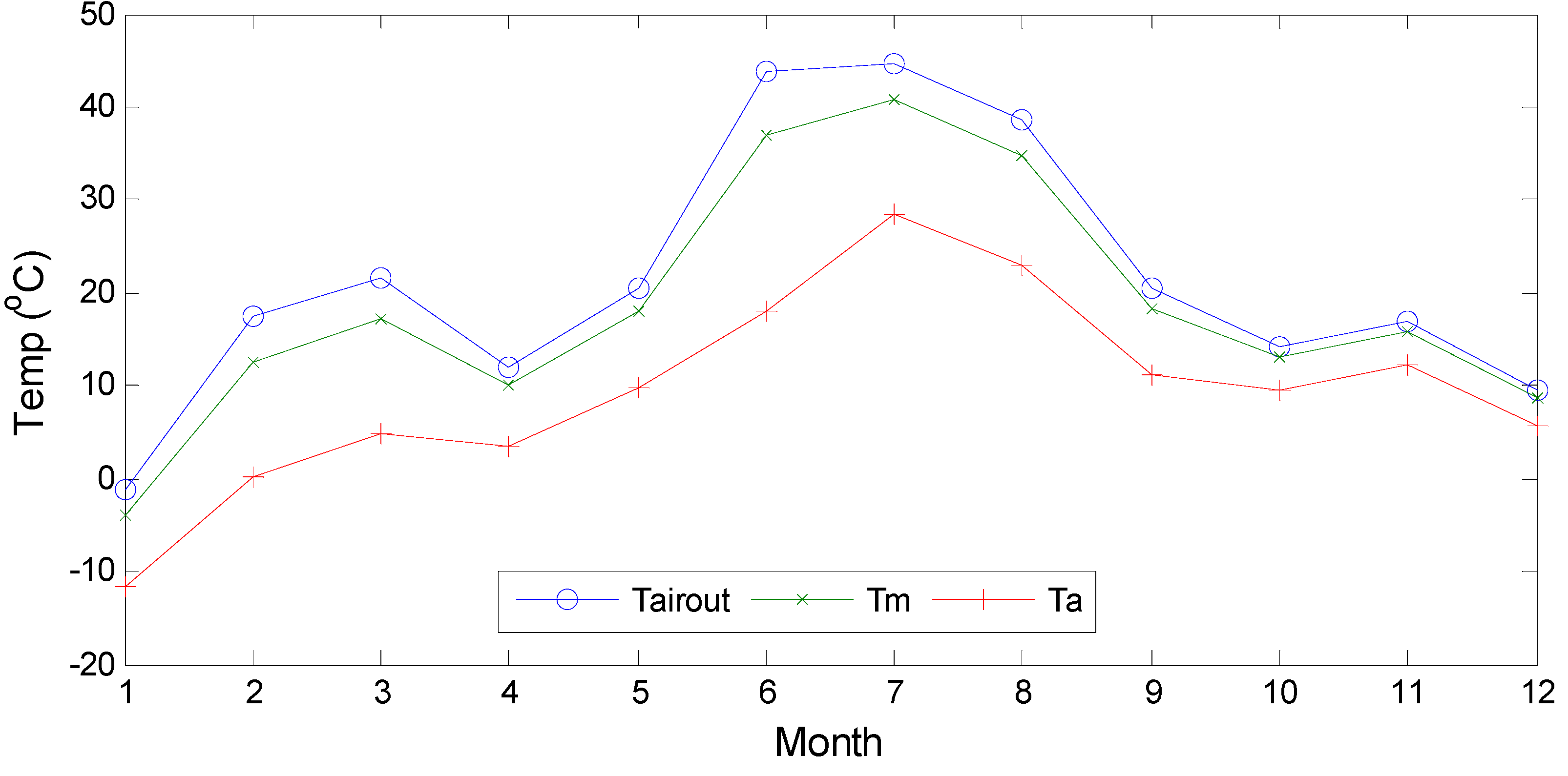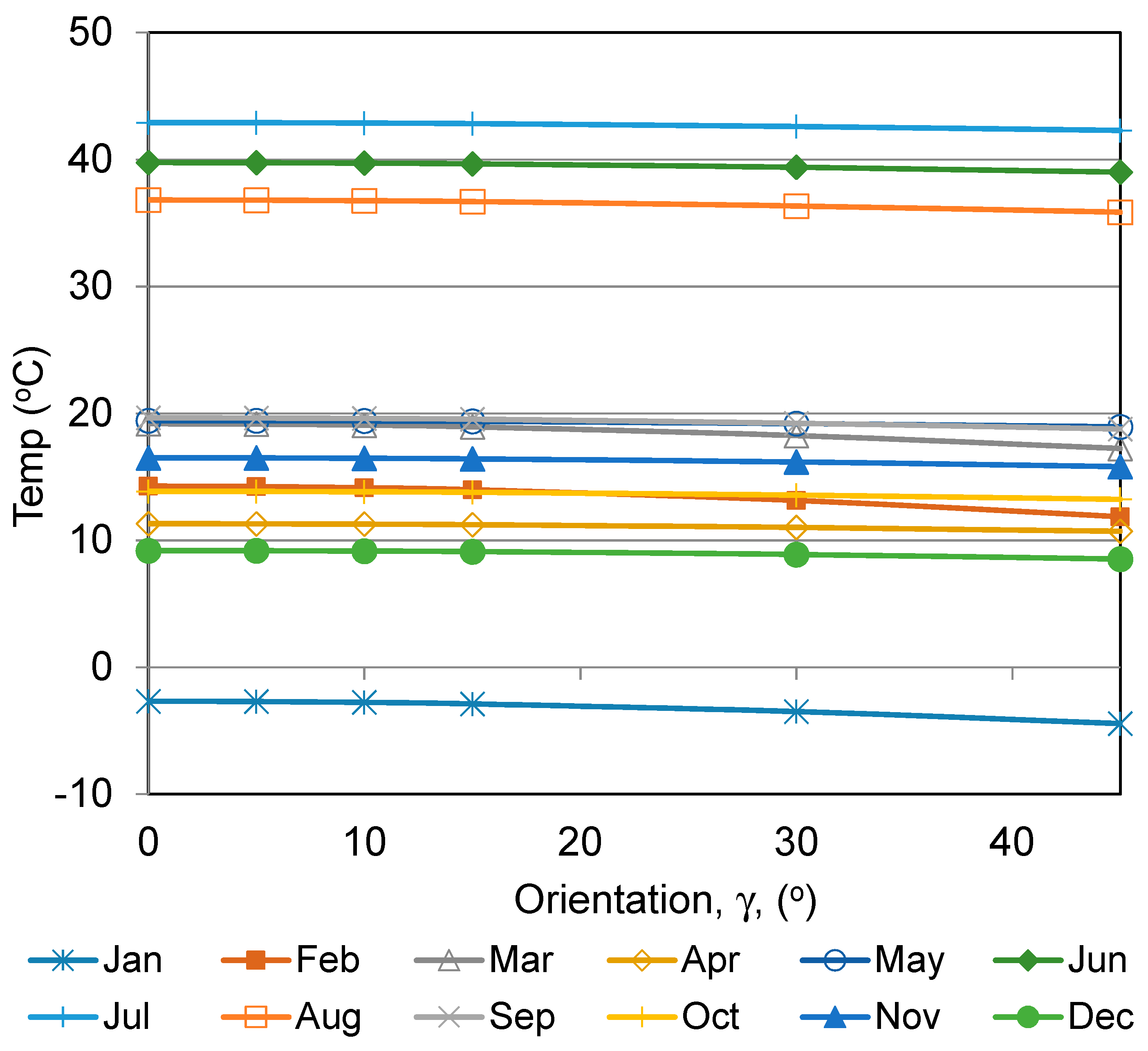1. Introduction
Solar energy has been recognized as an indigenous and unlimited source of energy. Solar energy boosts sustainability and energy security, leads to pollution reduction, keeps fossil fuel prices lower than otherwise, and lowers the cost of mitigating climate change [
1].
The quantity of solar energy received by a photovoltaic (PV) panel is determined by the local insolation and influenced by the orientation and tilt angle of the PV panels [
2,
3,
4,
5]. Proper installation of a PV panel, through appropriate inclination and orientation, should maximize the solar radiation received. Tracking systems that follow the course of the sun are used to maximize daily solar energy received by PV panels. However, because these devices are expensive and need energy for their operation it is recommended to find the best tilt and orientation angles. The tilt angle can be corrected from time to time, for example, seasonally [
6]. Generally, it is recommended that a PV system should be installed with a tilt angle which is equal to the latitude of the site [
2,
7].
Models have been proposed by several authors for the determination of the best (optimum) tilt angles. Although the models use the same technique of determining ground reflected and beam radiation they do differ in the way they convert the diffuse component value of a horizontal surface to that of a tilted surface [
6,
8,
9,
10]. The diffuse component is assumed to be anisotropic or isotropic. In isotropic models the intensity of the diffuse radiation is assumed to be uniformly distributed over the sky dome. On the other hand, anisotropy of the diffuse radiation in the circumsolar region (sky near the solar disk) plus isotopically distributed diffuse component from the rest of the sky dome is assumed in anisotropic models [
10].
Solar radiation prediction on inclined surfaces using both isotropic and anisotropic models has been presented by many researchers [
2,
6,
11,
12,
13,
14,
15,
16,
17,
18,
19,
20]. Benghanem [
6] conducted a case study for Madinah, Saudi Arabia. He found that the yearly optimum tilt angle was about the same to latitude of the site. This fixed tilt angle reportedly resulted in about 8% loss of collected energy when compared to the energy collected by tilting the PV monthly. Ulgen [
21] reported seasonal variation of the optimum tilt angle for a solar collector in Izmir, Turkey. For winter months, December, January, and February, the optimum tilt angle was found to be 55.7°. For spring months, March, April, and May, the optimum tilt angle was 18.3°. For summer months, June, July, and August, the optimum tilt angle was 4.3° and, finally, for fall months, September, October, and November, the optimum tilt angle was 43°. Beringer et al. [
22] conducted an experimental case study of optimum tilt angle of PV systems for Hannover, Germany. They determined that there was a small difference in the performance of PV cells at various tilt angles. They reported a difference of only 6% between yearly average and the summer season, and 10% for the winter season and the yearly average. They reasoned that this was due to the temperature that affects the performance of an open circuit voltage. The reduction in performance of the PV cells was due to higher temperature. Hachem et al. [
23] also came to a similar conclusion, and reported that the annual electricity generation of the building integrated photovoltaic/thermal (BIPV/T) system was not significantly affected by a tilt angle that ranged between 30° and 50° for the latitude considered (45° N).
The effect of tilt angle and air pollution on the amount energy collected by a photovoltaic module was investigated by Asl-Soleimani [
24] for Tehran, Iran. They found a 30° tilt angle to be the optimum, which is about 5° less than the latitude of the city. Also, they reported that the energy output of the modules was reduced by more than 60% due to the influence of air pollution.
Several researchers have used TRNSYS (Transient System Simulation Tool) simulation to investigate the effect of PV tilt angle and orientation on their performance. The performance of mono-crystalline silicon PV modules at various tilt angles and orientation was investigated using TRNSYS simulation for Cairo, Egypt, by Hussein et al. [
25]. They found that south-facing optimum tilt angle to vary between 20–30°. The impact of PV orientation and tilt angle on grid-connect PV performance in maritime climatic conditions was investigated using TRNSYS by Mondol et al [
7]. They found that south-facing orientation and a tilt angle of 30° leads to maximum PV output, while east and west orientations with 90° tilt lead to minimum PV output. The monthly optimum tilt angle varied from 10 to 70° [
7].
The negative impact of rising temperature on PV output has been reported by many researchers [
26,
27]. As mentioned previously, Beringer et al. [
22] reported that the temperature effect resulted in little differences in the performance (power output) of solar cells at various tilt angles. Circulation of air or water behind PV modules eliminates the heat, leading to enhanced performance of PVs. Photovoltaic/thermal (PV/T) systems enhance the electrical performance and provide thermal energy for use of space heating or domestic hot water heating. As a result, since the mid-1970s, PV/T systems have been researched intensively [
28,
29,
30,
31,
32,
33,
34,
35,
36,
37,
38,
39,
40,
41,
42,
43,
44,
45,
46].
The potential of water-based PV/T systems was evaluated by Kazem for the case of Sohar, Oman [
47]. He reported that the evaluated PV/T system showed better electrical performance during the testing period, with 6% higher power than a conventionally installed PV panel. Ramos et al. [
48] used TRNSYS to evaluate PV/T systems for space and domestic hot water heating application in various European cities. They found that 60% of the heating demand can be met in Seville, Rome, Madrid, and Bucharest. PVT systems coupled with borehole thermal energy storage systems (BTES) were studied by Aldybyan and Chiasson [
42], who reported electrical energy efficiency improvements of the PV/T cells by up to 4.7%. Abudullah et al. conducted a review of solar PV/T systems with different absorber designs and analyzed their potential performance and production efficiency [
49]. They reported that water-based PV/T systems have better performance as compared to the air-based PV/T systems. Chen and Dai [
50] compared the performance of flat plate solar thermal collectors to that of a PV/T collector and found that the PV/T collectors showed a delay on the dynamic response. They attributed this to the additional thermal capacity and thermal resistance of the PV/T systems.
In recent years, researchers have experimentally and numerically investigated the effect adding different types of nanoparticles has on the heat transfer characteristics of the fluid in PV/T systems [
51,
52,
53]. Ali et al. reported that nano-SiC resulted in higher convective heat transfer as compared to nano-CuO and nano-alumina [
52]. Ali et al. [
53] reported that adding nanofluid/nano-phase change material (PCM) to PV/T system resulted in electrical and thermal efficiencies of 13.7%, 13.2%, 72%, and 71.3%, respectively.
Buildings in geographical sites with low solar radiation and ambient temperatures require space heating for most of the year. Thus, PV/T systems that allow air circulation for removal of heat can be useful and cost effective [
54]. This conclusion is relevant to Canadian climatic conditions. Because of air circulation, thermal energy extraction, and enhanced performance, a PV/T system can lead to a quicker payback time as compared to a PV system alone. The most current practice of installing PV/T systems is as separate systems on rooftops, treating them as distinct systems from the building envelop. They are usually attached to the outer layer of the construction, requiring additional mounting systems. This leads to longer payback time. Integrating PV/T systems to the building envelope in a system known as building integrated photovoltaic thermal (BIPV/T) system has the possibility to meet all the building envelope needs such as thermal insulation and mechanical resistance [
23]. BIPV/T systems have several functions including electricity and thermal energy production. BIPV/T can also improve the cost effectiveness of building construction as compared to add-on PV/T systems [
23].
In summary, the orientation and tilt angle of a solar panel are important parameters that influence the output of the system and thus have been applied to solar thermal panels. However, there is limited work on optimizing the PV/T orientation and tilt angles for application in climatic conditions of the Greater Toronto Area (GTA), Canada. Specifically, the thermal output of a PV/T system has not been reported for GTA application. The potential of coupling a PV/T system to an air source heat pump will also be assessed.
The objective of this work was to determine optimum tilt and orientation angles of a PV/T systems for application in the Greater Toronto Area (GTA), Canada. The optimum tilt angles and orientations will be determined using four isotropic and four anisotropic models for the GTA climatic conditions. In addition, we intended to examine the influence of orientation of a PV/T system on the outlet temperature of the cooling air using a one-dimensional steady state heat transfer model.
2. Models for Determining Insolation on Tilted Surfaces
The overall solar radiation received on a surface is composed of (1) beam radiation, (2) diffuse radiation, and (3) reflected radiation [
6,
8,
55]. The beam radiation and the diffuse radiation on a horizontal surface with correlation procedures are used to obtain insolation on tilted surfaces [
8]. The monthly average daily total radiation on a tilted surface (
HT) is obtained from the direct beam (
HB), diffuse (
HD), and reflected components (
HR) of the radiation on a tilted surface. Thus, for a surface tilted from the horizontal, the incident total radiation (
HT) is given by [
7,
21,
55]:
where
HB is the daily beam radiation received on a tilted surface and is expressed as [
7]:
where
Hg,
Hd, and
Rb are the monthly mean daily global, the monthly mean daily diffuse radiation on a horizontal surface, and the ratio of the beam radiation on a tilted surface to that on a horizontal surface, respectively.
Rb, the ratio of the beam radiation on the tilted surface to that on a horizontal surface, is expressed as [
8]:
where
θ is the angle of incidence of beam radiation and cos(
θ) is expressed as [
8]:
where
φ is the latitude of the location,
δ is the declination,
ω is the hour angle,
β is the tilt angle, and
γ is the surface azimuth angle (
Figure 1).
The value of cos
(θz) is obtained by setting
β = 0° in Equation (4) [
8].
The declination,
δ, is expressed as [
8]:
where
n is the
nth day of the year. In this study, the values proposed by [
8] were used.
The daily ground-reflected radiation is expressed as [
7,
21]:
where
β is the tilt angle of the solar panel from horizontal and
ρ is the ground reflectance (ground or surface albedo). Its value varies from 0.2 for a snow-free surface and 0.6 with fresh snow [
55]. The sky-diffuse radiation is expressed by [
7,
8,
21]:
where
Rd is the ratio of the average daily diffuse radiation on a tilted surface to that on a horizontal surface. Four isotropic and four anisotropic models proposed by various investigators [
11,
12,
13,
14,
15,
16,
17,
18,
19] were used to calculate global radiation on tilted surfaces from the available data on a horizontal surface.
2.2. Anisotropic Models
where
Hb is the daily beam radiation incident on a horizontal surface,
Hg is the daily global radiation incident on a horizontal surface,
H0 is the extraterrestrial daily radiation incident on a horizontal surface, and
Rb is the ratio of the average daily beam radiation incident on an inclined surface to that on a horizontal surface given by Equation (3).
where
